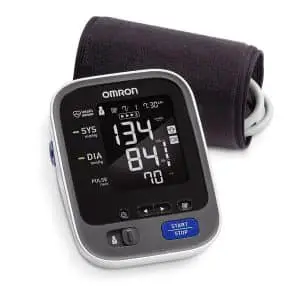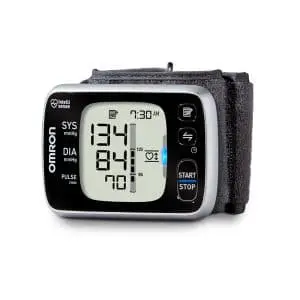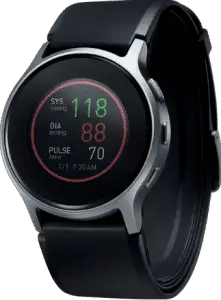Can any Smartwatch measure Blood Pressure? Yes, the Omron HeartGuide BP8000-M Smartwatch has a built-in oscillometric blood pressure measurement and it is also FDA cleared. Omron just launched the device at CES in January 2019 at a price of 499 USD. For someone who is recommended to measure blood pressure on a daily basis, this sounds like a really convenient option.
Update 16.5.2019: I wasn’t able to find the Omron HeartGuide BP8000-M on the Omron site in Europe and in the US if one tries to order one it says “Due to overwhelming consumer demand for HeartGuide, estimated shipping begins on September 15”. So it seems we need to wait for a while still before we can get our hands on this new innovation.
Why is blood pressure measurement important?
Blood pressure measurement is important because high blood pressure is an indication of an increased risk of health problems in the future. By monitoring your blood pressure you will know when to see a doctor and discuss preventive measures.
Healthy arteries are flexible, strong and elastic. Their inner lining is smooth so that blood flows freely, supplying vital organs and tissues with nutrients and oxygen. High blood pressure (Hypertension) is putting extra strain on your arteries and on your heart. Hypertension gradually increases the pressure of blood flowing through your arteries. This can lead to damaged and narrowed arteries since the higher pressure can damage your arteries and allow fats from your diet to collect in the arteries. Eventually, your artery walls become less elastic and thicker, limiting blood flow throughout your body.
Thicker artery walls make the arteries more narrow and more likely to become clogged up. This increases the risk of clots that can lead to a heart attack or stroke.
Note that the medical information presented here is gathered from the American Heart Associations web page.
The silent killer
You might have heard to high blood pressure being referred to as the “silent killer”. This is because most of the time, high blood pressure has no obvious symptoms to indicate that something is wrong. The best way to protect yourself if making yourself aware of the risks, making lifestyle changes which keep you healthy and monitoring your blood pressure from time to time.
Understanding your Blood Pressure Measurements
The below table shows what is considered normal, as recommended by the American Heart Association.
| BLOOD PRESSURE CATEGORY | SYSTOLIC mm Hg (upper number) | DIASTOLIC mm Hg (lower number) | |
|---|---|---|---|
| NORMAL | LESS THAN 120 | and | LESS THAN 80 |
| ELEVATED | 120 – 129 | and | LESS THAN 80 |
| HIGH BLOOD PRESSURE (HYPERTENSION) STAGE 1 | 130 – 139 | or | 80 – 89 |
| HIGH BLOOD PRESSURE (HYPERTENSION) STAGE 2 | 140 OR HIGHER | or | 90 OR HIGHER |
| HYPERTENSIVE CRISIS (consult your doctor immediately) | HIGHER THAN 180 | and/or | HIGHER THAN 120 |
Your blood pressure is recorded as two numbers
- Systolic blood pressure (upper number) – indicates how much pressure your blood is exerting against your artery walls when the heart beats.
- Diastolic blood pressure (lower number) – indicates how much pressure your blood is exerting against your artery walls while the heart is resting between beats.
Often more attention is given to the upper-pressure number as a major risk factor for cardiovascular disease. Many people experience an increase in systolic blood pressure with age. This is due to the increased stiffness of large arteries and the long-term buildup of plaque.
Devices for measuring your Blood Pressure
Cheap option for doing it at home
I think Omron is the most well-known brand of blood pressure monitors and they are also recommended by doctors for providing accurate results. So if you want a cheap high-quality upper arm blood pressure measurement unit you should be able to find something for around 40 USD.
Even the higher end Omron 10-series devices with memory for 200 measurements can be seen on offer for only 60USD. For 80USD you can get the same devices with Bluetooth connectivity allowing you to sync your measurements to a smartphone app.
Portable device for taking with you
Omron has also inexpensive portable devices for measuring your heart rate from the wrist.
The Omron 10-series Wireless Wrist Blood Pressure Monitor costs 80 USD looks like something you could take with you and easily measure your blood pressure in the office or while traveling. You couldn’t really wear it on your wrist all day since it would be like having a smartphone strapped to your wrist.
Omron HeartGuide BP8000-M Smartwatch and Wearable Blood Pressure Monitor
This is the first wearable blood pressure monitor and this makes me really excited.
Omron just launched this device at CES in January 2019. It’s available for preorder at a price of 500 USD and the estimated shipping time is at the end of March.
By placing the HeartGuide over your heart to record your blood pressure you can get clinically accurate readings in as little as 30 seconds. The device was also FDA approved since it’s based on the same oscillometric technology as the larger devices. It can also be programmed to take a reading during the night.
The design of HeartGuide involved more than 80 new patents that miniaturize the components for traditional oscillometric measurement, using an inflatable cuff within the watch band to take a blood pressure reading. This is a key differentiator that sets HeartGuide apart from other wearables that rely on sensor technology, which only provide blood pressure estimates.
Activity tracking, sleep quality and smart notifications
In addition to the blood pressure measurement feature, the HeartGuide tracks other metrics of health including daily steps and sleep quality.
The device also provides Bluetooth connectivity and a companion app so that you can see your data on the smartphone. You do get smart notifications on the device as well.
The device lacks continuous heart rate monitoring and GPS. I guess that’s understandable since this essentially is a medical device and not a multisport device. Maybe we will see in the future devices with more features.
Battery life
According to Omron, the watch will get anywhere between 30 and 50 inflations with a single charge. It is expected that the device will need charging once to three times a week depending on usage.
Design
The device is rather bulky at 115grams vs 39grams of the Garmin Vivoactive 3 and the thickness 14mm versus 11,7mm of the Garmin Vivoactive 3. It also looks large on the wrist in the videos Omron has provided.
Weight: Approximately 4.1 oz (115 g)
Dimensions: Diameter approximately 1.89” (48 mm), Case thickness approximately 0.55” (14 mm), Strap width approximately 1.18” (30 mm).
Conclusion
Omron has created a great device for monitoring your blood pressure. Even though it’s not yet as versatile as many other smartwatches and it’s fairly pricey it’s a huge step into the correct direction providing yet again new functionality to smartwatches.
I bet Omron is also thinking about what it can do with the massive amounts of blood pressure data it collects. Feeding this to data scientists creating artificial intelligence might bring us closer to preventing acute heart conditions weeks in advance.





